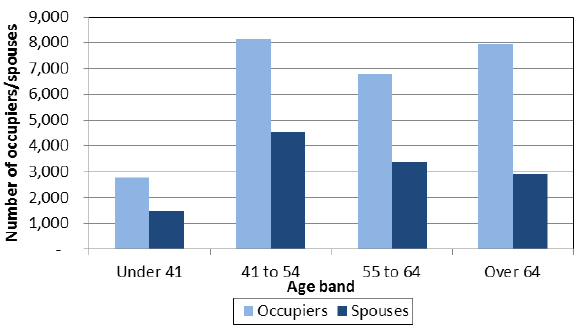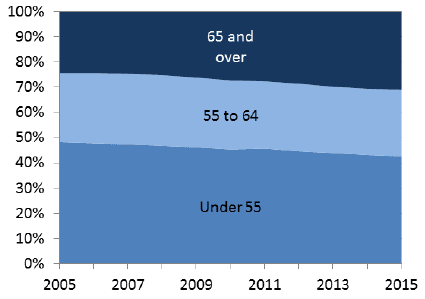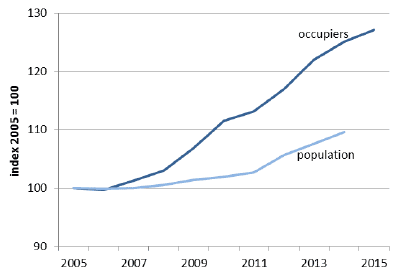Economic Report on Scottish Agriculture, 2016
Presents an overall picture of Scottish agriculture using data from the various agricultural surveys that RESAS manage.
This document is part of a collection
7.2 Structure of the workforce
7.2.1 Occupiers and spouses ( Tables C20, C21(i), C21(ii))
Just under 50 per cent of holdings in Scotland had a working occupier (25,700 holdings), and 24 per cent had a working spouse (12,300). For working occupiers this figure ranged from 41 per cent in Na h-Eileanan Siar to 62 per cent in Shetland, and for working spouses from 15 per cent in Na h-Eileanan Siar to 30 per cent in Dumfries and Galloway and Shetland. It should be noted however, that if an occupier or spouse was working on more than one holding, then they would only be recorded against one of these holdings.
In terms of the total workforce, occupiers and spouses made up 58 per cent of the total in Scotland. This percentage was lower in areas where agriculture activities that rely more heavily on employed labour (for example, horticulture) were prevalent, such as Tayside (31 per cent), Fife (38 per cent) and Lothian (39 per cent), but higher in areas such as Orkney (73 per cent), Highland (75 per cent), Shetland (84 per cent) and Na h-Eileanan Siar (90 per cent) where less labour intensive agricultural practices tended to prevail.
Table C20 shows the age and working pattern for working occupiers and spouses. It can be seen that 37 per cent of occupiers (9,500) were working full time on the holding while the other 63 per cent (16,100) were part time. In comparison only 14 per cent of spouses (1,700) worked full time while 86 per cent (10,600) worked part time.
Chart 7.2: Age of occupiers and spouses, June 2015

Regarding the age of working occupiers, chart 7.2 shows that over half (57 per cent or 14,700) were 55 years old or older and only 11 per cent (2,800) were under 41 years old. Working spouses tended to be younger with just over half being 55 or over (51 per cent or 6,300).
Chart 7.3 shows the broad age distribution of occupiers, with the proportion aged 65 and over now equal to 31 per cent and increasing over time.
It would be expected that the age profile for business owners would be older than that of the general population, particularly when the business is linked directly to the occupant's housing as it is in farming. It would also be expected that this proportion would be increasing, as it is in the population. Chart 7.4 however shows that the proportion of occupiers aged 65 plus has, in recent years, been increasing at a faster rate than in the population as a whole.
Chart 7.3: Age profile of occupiers, 2005 to 2015

Chart 7.4: Change in proportion of occupiers aged 65+, compared to change in general population

7.2.2 Regular employees ( Table C21(i), C21(ii))
There were a total of 20,600 regular employees (excluding occupiers and spouses) on agricultural holdings (13,300 full-time and 7,300 part-time) in Scotland in 2015. As with the total workforce, chart 7.1 shows that over half of regular employees were in either Grampian (3,200 or 16 per cent), Dumfries & Galloway (2,800 or 14 per cent), Tayside (2,700 or 13 per cent), or Highland (2,000 or ten per cent).
7.2.3 Casual and seasonal staff ( Table C21(i), C21(ii))
Of the total 6,800 casual and seasonal staff in Scotland, just under half (44 per cent or 3,000) were located in Tayside. Tayside and Fife were characterised by having a large casual and seasonal component to their workforce (36 and 26 per cent of their total workforce respectively), supporting the seasonal demand for harvesting fruit and vegetables.
Contact
There is a problem
Thanks for your feedback